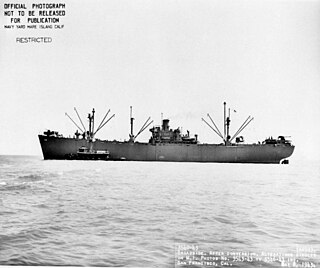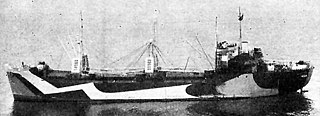Merchant service
Codington was leased by Coastwise Line for Military Sea Transportation Service, 7 May 1956, then sold to a South Korean buyer, 27 May 1956, for $693,862. She was renamed Pohang, for the South Korean city of Pohang, and reflagged South Korean.
On 11 November 1972, while discharging her cargo at Phnom Penh, Cambodia, she was damaged by a mine. She was able to proceed to Singapore, for dry docking. She was finally scrapped at Kaohsiung, Taiwan, January 1974.

USS Crater (AK-70) was the lead ship of her class of converted liberty ship cargo ships in the service of the US Navy in World War II. She was first named after John James Audubon, an American ornithologist, naturalist, and painter. She was renamed and commissioned after the constellation Crater, she was the only ship of the Navy to bear this name.
USS Habersham (AK-186) was an Alamosa-class cargo ship that served the US Navy during the final months of World War II. She was named for Habersham County, Georgia.

USS Eridanus (AK-92) was a Crater-class cargo ship commissioned by the US Navy for service in World War II and manned by a US Coast Guard crew. She was named after the constellation Eridanus. She was responsible for delivering goods and equipment to locations in the war zone.

USS Alamosa (AK-156) was the lead ship of the Alamosa-class cargo ships, commissioned by the US Navy for service in World War II. She was responsible for delivering troops, goods and equipment to locations in the war zone.

USS Amador (AK-158) was an Alamosa-class cargo ship commissioned by the US Navy for service in World War II. She was responsible for delivering troops, goods and equipment to locations in the war zone.
USS Clarion (AK-172) was an Alamosa-class cargo ship commissioned by the U.S. Navy for service in World War II. She was responsible for delivering troops, goods and equipment to locations in the war zone.
USS Craighead (AK-175) was an Alamosa-class cargo ship commissioned by the U.S. Navy for service in World War II. She was responsible for delivering troops, goods and equipment to locations in the war zone.
USS Lebanon (AK-191) was a Alamosa-class cargo ship constructed for the US Navy during the end of World War II. However, as the war was ending, the need for additional cargo ships was found not necessary and Lebanon was sold for commercial service.

USS Poinsett (AK-205) was an Alamosa-class cargo ship acquired by the US Navy just prior to the end of World War II. She carried supplies and ammunition to the Pacific Ocean battle areas and was awarded one battle star for her operations in the Borneo area.

USS Faribault (AK-179) was an Alamosa-class cargo ship acquired by the U.S. Navy during the final months of World War II. Faribault served US military forces in the Pacific Ocean until shortly after the war when she was deactivated. During the Korean War, she was reactivated and served with distinction, having been awarded two battle stars before final decommissioning.
USS Fentress (AK-180/T-AK-180) was an Alamosa-class cargo ship acquired by the US Navy during the final months of World War II. In 1950, she was reactivated and placed into service with the Military Sea Transportation Service as USNS Fentress. She was ultimately transferred to the Trust Territory of the Pacific Islands and the Republic of the Marshall Islands.

USS Grainger (AK-184) was an Alamosa-class cargo ship that served the US Navy during the final months of World War II. In 1947 she was placed back in service and served in the Korean War, earning two battle stars
USS Hennepin (AK-187) was an Alamosa-class cargo ship that served the US Navy during the final months of World War II. Post-war she served briefly with the US Army as USAT Hennepin, and then as USNS Hennepin (T-AK-187) with the Military Sea Transportation Service (MSTS) where she was awarded a battle star. She was declared excess-to-needs on 27 March 1959.
USS Kenosha (AK-190) was an Alamosa-class cargo ship that served the US Navy during the clean-up phase of World War II. When her service was no longer required in 1946, she was decommissioned and returned to the U.S. Maritime Commission where she was sold to the Kingdom of Norway in 1947.
USS Lehigh (AK-192) was an Alamosa class cargo ship that was constructed by the United States Navy during the closing period of World War II. She was declared excess-to-needs and returned to the United States Maritime Commission shortly after commissioning.
USS Midland (AK-195) was an Alamosa-class cargo ship that was constructed by the US Navy during the closing period of World War II. She was declared excess-to-needs and returned to the US Maritime Commission shortly after being in commission for only a short period of time.
USS Muskingum (AK-198/T-AK-198) was an Alamosa-class cargo ship that was constructed for the US Navy under a US Maritime Commission (MARCOM) contract during the closing period of World War II. She supported the end-of-war Navy effort. On 7 March 1946 Muskingum was placed in service under bareboat charter with the US Army under the Shipping Control Authority for the Japanese Merchant Marine with a Japanese crew. In 1950, she was reactivated and placed into service with the Military Sea Transportation Service as USNS Muskingum (T-AK-198) until being struck from the Navy list in 1973. She was ultimately transferred to the Trust Territory of the Pacific Islands (TTPI) and the Republic of Palau.
USS Hidalgo (AK-189) was an Alamosa-class cargo ship that was constructed for the U.S. Navy during the closing period of World War II. She was declared excess-to-needs and returned to the U.S. Maritime Commission.
USS Rockdale (AK-208) was an Alamosa-class cargo ship that was constructed for the US Navy during the closing period of World War II. She served with distinction in the Pacific Ocean theatre of operations and returned home in 1946 to be placed into the "mothball" fleet and sold in 1947.
USS Schuyler (AK-209) was an Alamosa-class cargo ship that was constructed for the US Navy during the closing period of World War II. She served with distinction in the Pacific Ocean theatre of operations and returned home in 1946 to be placed into the reserve "mothball" fleet where she silently remained until she was scrapped in 1971.
This page is based on this
Wikipedia article Text is available under the
CC BY-SA 4.0 license; additional terms may apply.
Images, videos and audio are available under their respective licenses.






